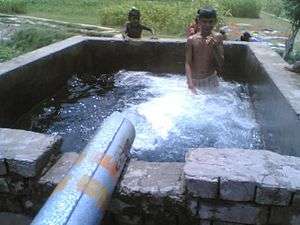Tube well


A tube well is a type of water well in which a long 100–200 millimetres (3.9–7.9 in) wide stainless steel tube or pipe is bored into an underground aquifer. The lower end is fitted with a strainer, and a pump lifts water for irrigation. The required depth of the well depends on the depth of the water table.

Temporary reservoir
A small reservoir of water is made at the outlet of the tube well. This reservoir is used for different usage of water by the local population.
Drive mechanism
In the past, the pump was typically driven by a large diesel engine. Today electric motors are more commonly used on account of economy.
Casing
The tube well casing houses the inlet, cylinder, piston valves and rising main of a "down-the-hole" type hand pump. Casing to support the external surfaces of the borehole against collapse may be needed, either temporarily or permanently, and is often made of PVC pipe, which is both cheap and inert.
Seepage down the tube well bore is prevented by the sanitary seal. Seepage from the ground above the aquifer is excluded by the lengths of plain casing. Water to be pumped is admitted through slots in the lower lengths of casing.
Water abstracted from aquifers in relatively soft ground usually contains sand or silt particles, which are liable to cause rapid wear to pump valves and cylinders (and dissatisfaction among consumers). Methods of preventing these particles from reaching the pump are of two general types, screening and sand/gravel packing.
Screening
The drawing shows slots in the PVC casing which can be cut on site, using a hacksaw and it is sealed
Sand/gravel packing
The drawing shows graded sand and gravel, which is placed from the top of the borehole. More compact, pre-bonded, packs of sand and/or gravel are available commercially; some of these can also form part of the pump inlet assembly. Sand and/or gravel packing is meant to eliminate particles from the water before they reach the screen and that would otherwise have passed through
Ground Water Safety
The introduction of tube wells has led to major arsenic poisoning in Bangladesh.[1] High concentrations of arsenic occur naturally in the soil in some areas of Bangladesh.